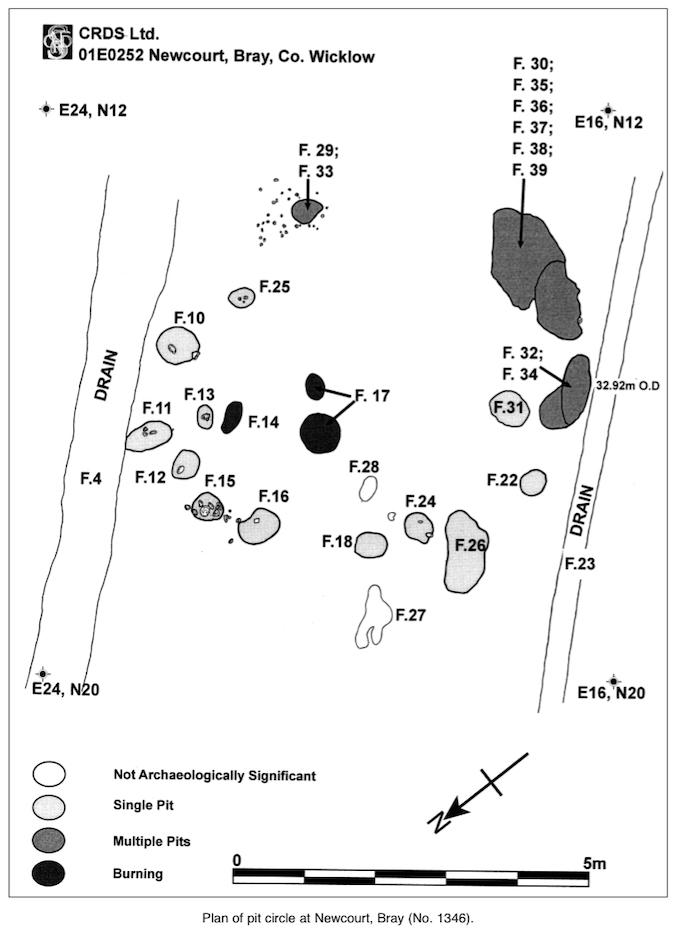County: Wicklow Site name: BRAY: Putland Road, Newcourt
Sites and Monuments Record No.: N/A Licence number: 01E0252
Author: Richard Clutterbuck, Cultural Resource Development Services Ltd.
Site type: Pit circle
Period/Dating: Prehistoric (12700 BC-AD 400)
ITM: E 727044m, N 717452m
Latitude, Longitude (decimal degrees): 53.192332, -6.098792
This site was discovered during monitoring (No. 1344, Excavations 2001, 01E0084) on a north-facing slope adjacent to the development site boundary wall. It was excavated between 6 March and 4 April 2001, within a 20m by 30m grid. Twenty-seven features were identified in two distinct groups containing burning, 14m apart.
The first group consisted of two pits and a patch of burnt soil. The second and more substantial group consisted of a subcircular collection of 24 features, 7m by 6m in extent, with evidence for burning within. The majority of the features were pits with single fills cut into the natural subsoil. Most were very shallow and appear to have been heavily truncated by ploughing. They ranged in size from 1.44m by 0.85m to 0.34m by 0.24m, and in depth from 0.04m to 0.44m, with an average depth of 0.14m. The fills generally consisted of brown sandy clay with inclusions of diffuse charcoal flecks. Samples of fills from the pits have been sent for analysis, revealing a mixture of animal and human bone in one (F.22). A series of pits were found cut into one another; two post-holes may have marked their position. A number of these pits may have been recut. Eight pits and the central burnt area contained inclusions of burnt and crushed bone. The burnt soil in the centre of the group of pits appears to have been contained in a pit.
Of the 101 finds, all stone, recovered, 80 were from the topsoil. The finds consist of four chert waste flakes, two quartz waste flakes, 76 waste flint flakes, ten worked flint tools and nine flint nodules which appear to have been used as cores. The tools consist of six scrapers made from flakes off water-rolled pebbles, one thumbnail scraper, two flint blades and one flint borer. The finds can generally be dated to the late Neolithic or early Bronze Age (c. 2800–c. 1700 BC) and were the result of tool production.
The pits constituting this site were grouped in a rough circle centred on an isolated area of burning. This suggests that the site was deliberately arranged to focus activity within. The site does not appear to be the remains of a building, although several of the features may be post-holes from which the posts were removed. However, in the majority of cases the pits appear to have been dug specifically to receive deposits; in some cases posts may have acted as markers. Although there is definite evidence for burning within the circle, as well as fragments of crushed cremated animal and human bone, the burning is too limited to constitute a cremation site. Finds from the site were mainly flint débitage from tool production: cores, picked up as beach cobbles on Bray beach. The finds would appear to be consistent with a domestic site. However, the interment of crushed human bone suggests that this was the focus of a ritual. The bone fragments from the pits are more consistent with the interment of a token portion of the individual’s remains. Charcoal samples have been sent for dating. The site was fully excavated and recorded before construction work reduced the area.

Campus Innovation Centre, Roebuck, UCD, Belfield, Dublin 4